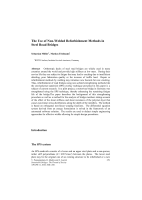Bridges

- Publication no: ABC-IAR009-11
- Published: 31 October 2011
- PDF (free) Download
Orthotropic decks of steel road bridges are widely used in many countries around the world and provide high stiffness at low mass. During their service life they are subject to fatigue that may lead to cracking due to insufficient detailing, poor fabrication quality or the increase of traffic load. Repair or refurbishment methods by welding may introduce new hazards for new cracking. Thus, refurbishment of road bridges using non-welded strengthening methods like the steel-polymer-sandwich (SPS) overlay technique presented in this paper is a subject of current research. In a pilot project, a motorway bridge in Germany was strengthened using the SPS technique, thereby enhancing the remaining fatigue life of the bridge.The paper describes the background of this strengthening procedure as well as a method for the analysis of bridge members taking account of the effect of the shear stiffness and shear resistance of the polymer-layer that causes non-linear stress distributions along the depth of the members. The method is based on orthogonal non-linear warping functions. The differential equation system derived from an energy formulation is solved in the framework of an automated software solution. The results are used to deduct simple engineering approaches for effective widths allowing for simple design procedures.
